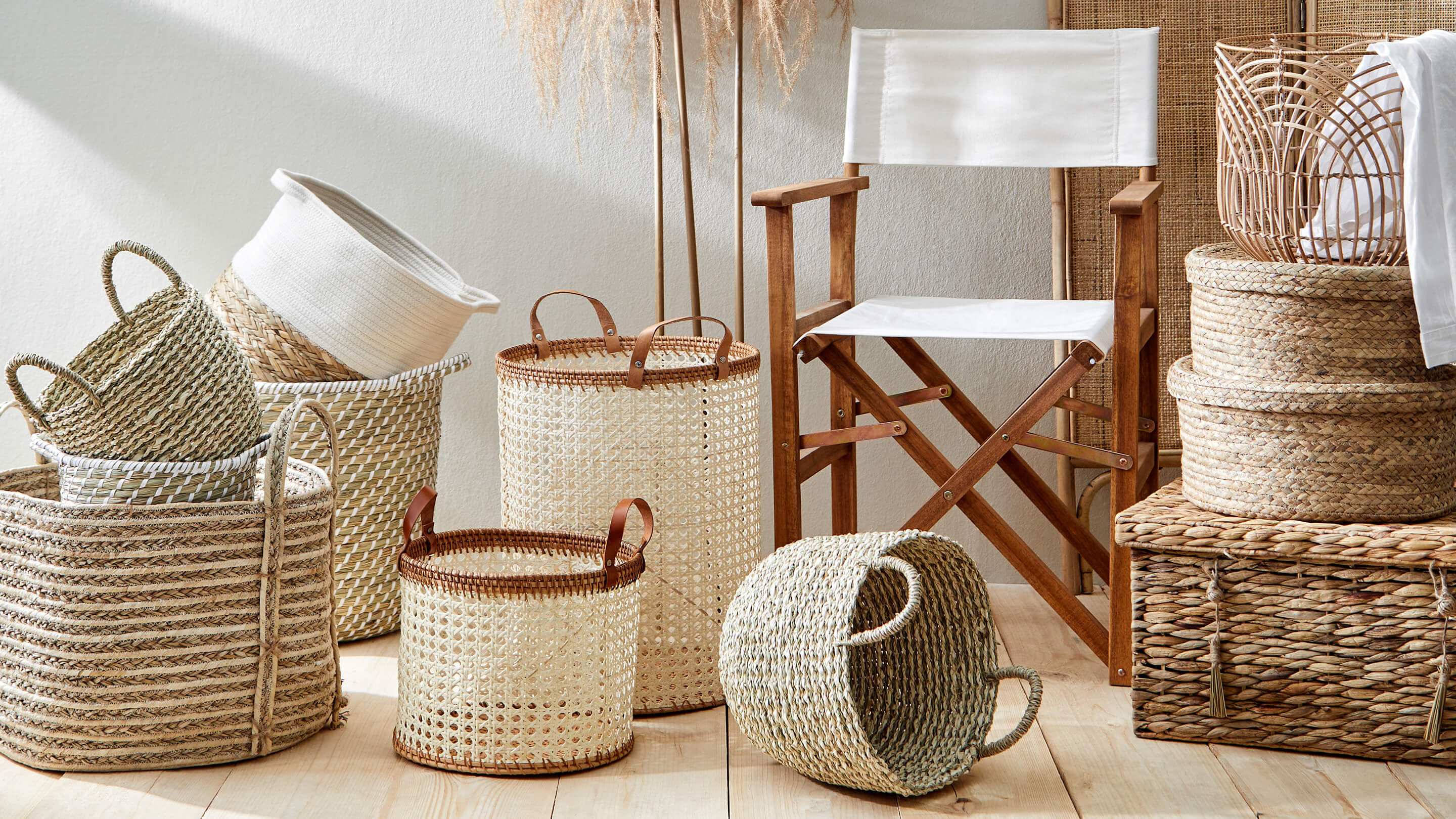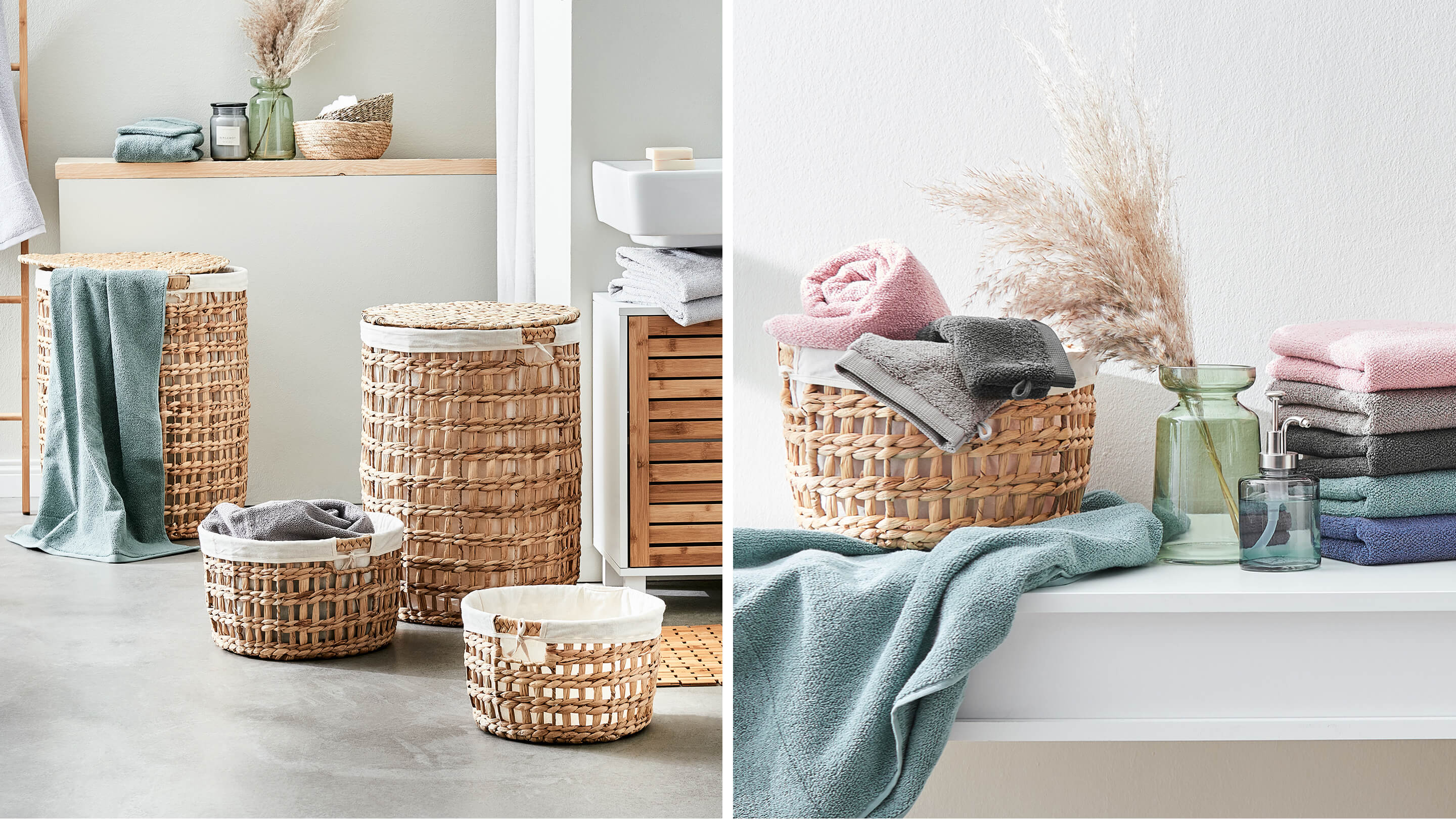
One prettier than the other: baskets made of natural materials are pretty eye-catchers and practical order keepers.
WICKER PRODUCTS MADE FROM NATURAL FIBERS FOR A GOOD INDOOR CLIMATE
It used to be said: into the basket and then please, including the basket, out of sight. Today, however, baskets and chests are more than just practical order keepers for candles, pens, batteries and decorations lying around. Even without content, they are real beauties, which, as a chic eye-catcher, make every room look pretty.
Hand-woven baskets made from natural fibers are particularly impressive. You are currently fully inNatural living trend, where you make your home as beautiful as possible in a natural way and value ecologically sustainable furniture and accessories made from renewable raw materials. This creates a pleasant, cozy, warm living environment that gives value to the things we surround ourselves with. In this blog post we introduce you to the most common natural fibers for baskets and chests.
WHY BASKETS ARE A GOOD CHOICE

Baskets are available in many different natural earth and sand tones, in black and white.
Whether small, medium or large. Round, square, with or without a lid: the possible uses of baskets are at least as versatile as their shape, color and size. Almost everything can be perfectly stowed in them - in the bathroom as well as in the living room or bedroom. Plaited goods made from natural materials are versatile and easy to care for. With their restrained colors and patterns, they ensure a good room climate, cosiness and a nice feeling of living. Many natural fibers are also sustainable because they grow back quickly and are easy to grow.
In addition, the natural, subtle look of models made from seaweed, water hyacinth and the like is extremely compatible with a wide range of interior design styles. If that's not a good reason to love her!
BASKETS MADE FROM THESE NATURAL FIBERS ARE A HIT:
# 1 WATER HYACINTH

It is pure coincidence that baskets made of water hyacinth feel good in your bathroom of all places!
The water hyacinth is a rush-like wicker material that can be found in stagnant water, primarily in South America and Asia. Because it grows extremely quickly and thus spreads rapidly, it has earned the reputation of "super weed" and has actually led to environmental problems here and there. Their use for the production of all kinds of wickerwork, from furniture to home accessories, is therefore sensible from an ecological point of view. In addition, their economic cultivation creates jobs in the countries of origin.
Only the plant stems are used to weave baskets and the like. They are very flexible and stable at the same time. The stems are first dried, then mangled and pulled onto racks by hand or braided into ropes. Different patterns such as B. plaits or herringbone weave. Since wickerwork made from water hyacinth is a natural product, each piece is unique and may vary in color.
The advantage of baskets made of water hyacinth is that they are very easy to care for. Every now and then they should be wiped off with a cloth (dampened with moisture). If you want to make your baskets shine, you can grease them with very little vegetable oil every now and then.
# 2 SEAWEED

Seagrass and co. are by no means everything: beautiful wickerwork can also be made from typha (cattails) and rattan.
You have undoubtedly encountered seaweed on the beaches of the North and Baltic Seas. There it is washed up together with algae as flotsam and is often perceived as a nuisance. Seagrass plays an important role in the marine ecosystem as a supplier of oxygen and a habitat for animals. Its versatile use as fertilizer, insulating, filling or upholstery material and for the production of home accessories also makes seagrass a coveted and high-quality raw material.
The fact that the water plant is so popular is due, among other things, to its numerous positive properties: It is malleable, recyclable, flame retardant, mold resistant and regulates moisture. Since it also has a high load capacity, it is predestined for the production of wicker.
With their natural look and pleasant scent of sea breeze, seagrass baskets are a wonderful addition to a maritime style of living. As with water hyacinth wicker, you can simply use a damp cloth to remove dust and care for it.
#3 JUTE

Strong! The particularly tear-resistant and durable jute yarn is often used for braided goods.
Whether for the production of clothing, decorative or home accessories: The good jute has been used in many ways since the 16th century. Their homeland is in India and Pakistan. Believe it or not, it is considered the strongest and most durable natural fiber in the world, making it the most important natural yarn alongside cotton.
In the vernacular, jute is often called "golden fibre", which is due to its silky golden sheen. Like other natural fibers, jute twine is environmentally friendly as it is fully biodegradable and has a long shelf life.
Jute is very popular in interiors. It is used to produce decorative items with an authentic, natural look, e.g. B. Used at Christmas time or by carpets, as the fabric is antistatic. Because it is tear-resistant, absolutely easy to care for and breathable, all kinds of woven goods such as storage baskets are made from it.
If you are in the mood for unobtrusive naturalness and cosiness in your own four walls, you will find it hard to get past deco accessories made of jute.
# 4 COTTON

Teamwork: In the BUTLERS "Cotton Braid" series, the braids are made of cotton and seaweed.
Whether cuddly pillows and blankets, clothing, carpets or towels: when it comes to flattering, hard-wearing textiles, there is no getting around cotton. It is the most frequently used natural fiber in the home and textile industry and, as just mentioned, next to jute, it is the most important yarn of all!
The cotton plant is a mallow family that thrives mainly in tropical and subtropical countries. The largest countries of origin are China, India, Brazil, but also the USA.
Since it is skin-friendly and has a low allergy potential, cotton fibers are particularly interesting for the textile industry. But it is also extremely popular in the manufacture of home textiles. It owes this primarily to its numerous positive properties: It is easy to care for, durable, light in weight and breathable, which is why it is well and popularly used for the production of bed linen. It is also easy to dye, which distinguishes it from other natural fibers such as jute.
Storage baskets are also popular with cotton because they are softer, more flexible and easy to clean. Models in which cotton fibers are combined with other natural yarns are particularly beautiful.
It is encouraging that organic cotton is being used more and more frequently. I. E. Cotton that is produced according to the guidelines of organic farming. When buying appropriate textiles, it is best to pay attention to the corresponding certifications. The GOTS certificate is a trustworthy, independent seal that is recognized worldwide. This is awarded to textiles whose manufacture complies with high environmental and social criteria along the entire textile production chain.

